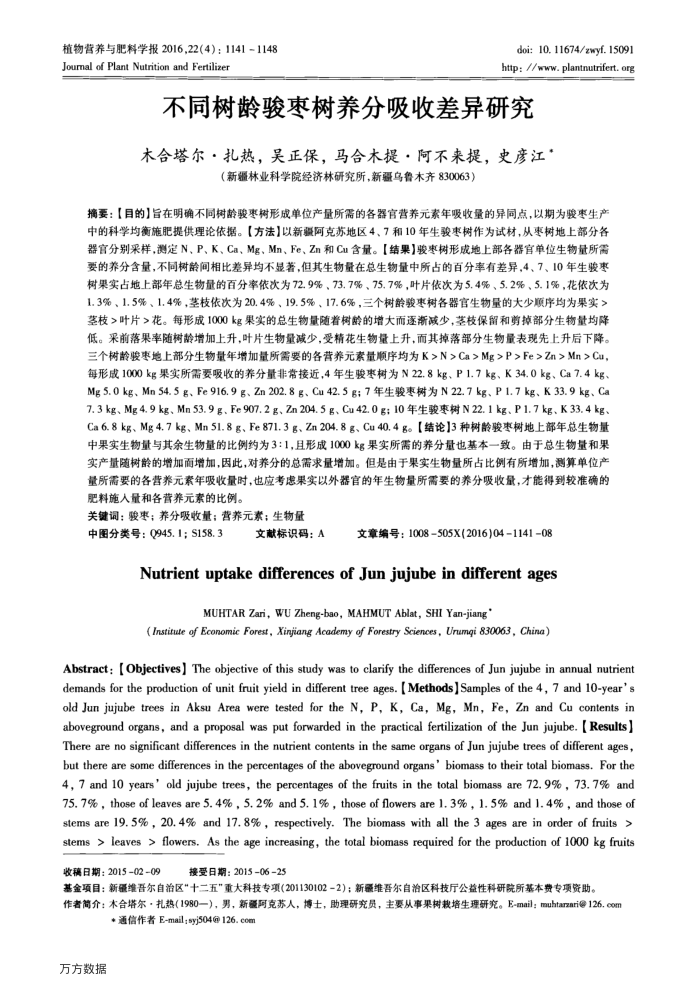您当前的位置:首页>论文资料>不同树龄骏枣树养分吸收差异研究
内容简介
 植物营养与肥料学报2016,22(4):1141-1148 Jourmal of Plant Nutrition and Fertilizer
植物营养与肥料学报2016,22(4):1141-1148 Jourmal of Plant Nutrition and Fertilizerdoi: 10, 11674/zwyf. 15091 http://www.plantnutrifert.org
不同树龄骏枣树养分吸收差异研究
木合塔尔·扎热,吴正保,马合木提·阿不来提,史彦江*
(新疆林业科学院经济林研究所,新疆乌鲁木齐830063)
摘要:【目的】旨在明确不同树龄骏枣树形成单位产量所需的各器官营养元素年吸收量的异同点,以期为骏枣生产器官分别采样,测定N、P、K、Ca、Mg、Mn、Fe、Zn和Cu含量。【结果】骏枣树形成地上部各器官单位生物量所需
1.3%、1.5%、1.4%,茎枝依次为20.4%、19.5%、17.6%,三个树龄枣树各器官生物量的大少顺序均为果实> 茎枝>叶片>花。每形成1000kg果实的总生物量随着树龄的增大而逐渐减少,茎枝保留和剪掉部分生物量均降低。采前落果率随树龄增加上升,叶片生物量减少,受精花生物量上升,而其掉落部分生物量表现先上升后下降。三个树龄骏枣地上部分生物量年增加量所需要的各营养元素量顺序均为K>N>Ca>Mg>P>Fe>Zn>Mn>Cu,每形成1000kg果实所需要吸收的养分量非常接近,4年生骏枣树为N22.8kg、P1.7kg、K34.0kg、Ca7.4kg、
Mg 5. 0 kg、Mn 54. 5 g、Fe 916. 9 g、Zn 202. 8 g
Cu42.5
7. 3 kg、 Mg 4. 9 kg, Mn 53. 9 g, Fe 907. 2 g, Zn 204. 5 g.
7年生骏枣树为N22.7kg、P1.7kg、K33.9kg、Ca
Cu42. 0 g;10年生骏枣树N22.1kg、P1.7kg、K33.4kg、
Ca6.8kg、Mg4.7kg、Mn51.8g、Fe871.3g、Zn204.8g、Cu40.4g。【结论]3种树龄骏枣树地上部年总生物量中果实生物量与其余生物量的比例约为3:1,且形成1000kg果实所需的养分量也基本一致。由于总生物量和果实产量随树龄的增加面增加,因此,对养分的总需求量增加。但是由于果实生物量所占比例有所增加,测算单位产
肥料施人量和各营养元素的比例。
关键调:骏枣;养分吸收量;营养元素;生物量
中图分类号:Q945.1;S158.3
文献标识码:A
文章编号:1008505X(2016)04114108
NutrientuptakedifferencesofJunjujubeindifferentages
MUHTAR Zari,WU Zheng-bao,MAHMUT Ablat,SHIYan-jiang
( Institute of Economic Forest, Xinjiang Academy of Forestry Sciences, Urumgi 830063, China)
Abstract: [Objectives] The objective of this study was to clarify the differences of Jun jujube in annual nutrient demands for the production of unit fruit yield in different tree ages. [Methods]Samples of the 4, 7 and 10-year' s old Jun jujube trees in Aksu Area were tested for the N, P, K, Ca, Mg, Mn, Fe, Zn and Cu contents in aboveground organs, and a proposal was put forwarded in the practical fertilization of the Jun jujube. [Results] There are no significant differences in the nutrient contents in the same organs of Jun jujube trees of different ages, but there are some differences in the percentages of the aboveground organs' biomass to their total biomass. For the 4, 7 and 10 years' old jujube trees, the percentages of the fruits in the total biomass are 72. 9% , 73. 7% and 75. 7% , those of leaves are 5. 4% , 5. 2% and 5. 1% , those of flowers are 1. 3% , 1. 5% and 1. 4% , and those of stems are 19. 5% , 20. 4% and 17. 8% , respectively. The biomass with all the 3 ages are in order of fruits > stems > leaves > flowers. As the age increasing, the total biomass required for the production of 1000 kg fruits
收稿日期:201502-09
接受日期:201506-25
基金项目:新蛋维吾尔自治区“十二五"重大科技专项(201130102-2);新疆维吾尔自治区科技厅公益性科研院所基本费专项资助。
作者简介:本合塔尔·扎热(1980一),男,新强阿克苏人,博士,助理研充员,主要从事果树裁培生理研究。E-mail:muhtarzari@126.com
+通信作者E-mail:syj504@126.com
万方数据
上一章:氮肥用量及其基追施比例对烤烟氮素利用的影响
下一章:黄土塬面果园土壤养分特征及演变